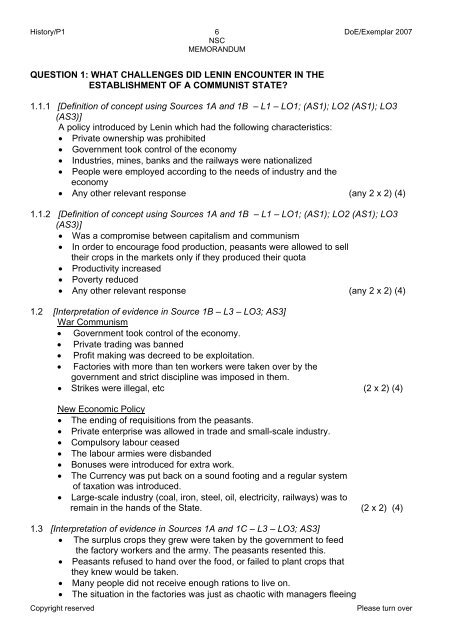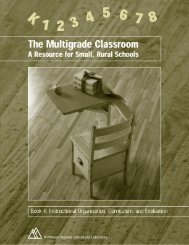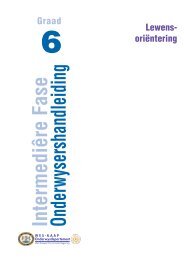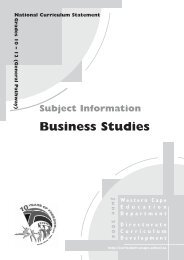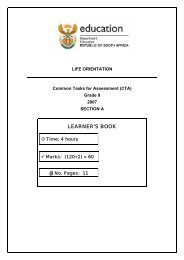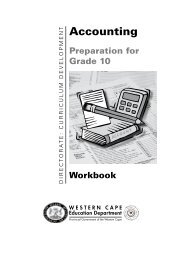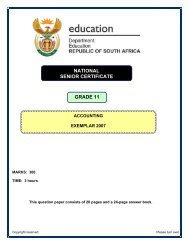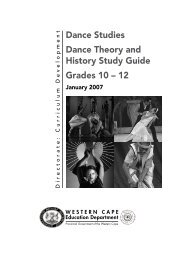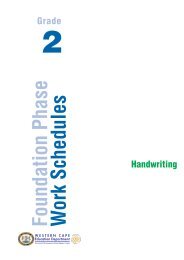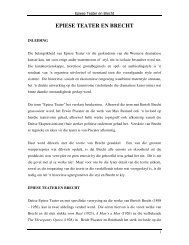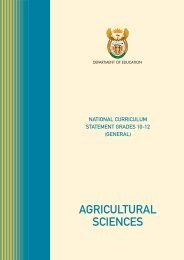FINAL Memo - History P1 - Exemplar 2007.pdf - Curriculum ...
FINAL Memo - History P1 - Exemplar 2007.pdf - Curriculum ...
FINAL Memo - History P1 - Exemplar 2007.pdf - Curriculum ...
You also want an ePaper? Increase the reach of your titles
YUMPU automatically turns print PDFs into web optimized ePapers that Google loves.
<strong>History</strong>/<strong>P1</strong> 6DoE/<strong>Exemplar</strong> 2007NSCMEMORANDUMQUESTION 1: WHAT CHALLENGES DID LENIN ENCOUNTER IN THEESTABLISHMENT OF A COMMUNIST STATE?1.1.1 [Definition of concept using Sources 1A and 1B – L1 – LO1; (AS1); LO2 (AS1); LO3(AS3)]A policy introduced by Lenin which had the following characteristics:• Private ownership was prohibited• Government took control of the economy• Industries, mines, banks and the railways were nationalized• People were employed according to the needs of industry and theeconomy• Any other relevant response (any 2 x 2) (4)1.1.2 [Definition of concept using Sources 1A and 1B – L1 – LO1; (AS1); LO2 (AS1); LO3(AS3)]• Was a compromise between capitalism and communism• In order to encourage food production, peasants were allowed to selltheir crops in the markets only if they produced their quota• Productivity increased• Poverty reduced• Any other relevant response (any 2 x 2) (4)1.2 [Interpretation of evidence in Source 1B – L3 – LO3; AS3]War Communism• Government took control of the economy.• Private trading was banned• Profit making was decreed to be exploitation.• Factories with more than ten workers were taken over by thegovernment and strict discipline was imposed in them.• Strikes were illegal, etc (2 x 2) (4)New Economic Policy• The ending of requisitions from the peasants.• Private enterprise was allowed in trade and small-scale industry.• Compulsory labour ceased• The labour armies were disbanded• Bonuses were introduced for extra work.• The Currency was put back on a sound footing and a regular systemof taxation was introduced.• Large-scale industry (coal, iron, steel, oil, electricity, railways) was toremain in the hands of the State. (2 x 2) (4)1.3 [Interpretation of evidence in Sources 1A and 1C – L3 – LO3; AS3]• The surplus crops they grew were taken by the government to feedthe factory workers and the army. The peasants resented this.• Peasants refused to hand over the food, or failed to plant crops thatthey knew would be taken.• Many people did not receive enough rations to live on.• The situation in the factories was just as chaotic with managers fleeingCopyright reservedPlease turn over


